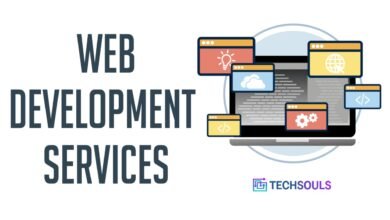How to Build a Website from Scratch: A Step-by-Step Guide

In today’s digital age, having and building a website is crucial for individuals and businesses alike. Whether you want to showcase your portfolio, start an online business, or create a personal blog, building a website from scratch is a skill that can open up a world of possibilities. In this comprehensive guide, we will walk you through the step-by-step process of creating your very own website. From domain registration to designing and launching your site, we’ve got you covered.
Read More: Web Development Services in the UK: Build Your Online Presence
How to Build a Website from Scratch

Choosing a Domain Name
Your website’s domain name is its online identity. Selecting a domain name that reflects your website’s purpose, is easy to remember, and is relevant to your content is essential. Here are some tips:
- Keep it concise: Shorter domain names are easier to remember.
- Be unique: Check domain availability to ensure no one else is using the same name.
- Avoid special characters and hyphens: These can make your domain harder to type and remember.
- Think about keywords: If possible, include relevant keywords that describe your website’s content.
Once you’ve chosen a domain name, you can register it through a domain registrar like GoDaddy or Namecheap.
Selecting a Hosting Provider
Web hosting is where your website’s files and data are stored, making them accessible on the internet. When choosing a hosting provider, consider these factors:
- Uptime: A reliable hosting provider should offer high uptime (99.9% or better).
- Customer Support: Opt for a host with excellent customer support to assist you in case of issues.
- Pricing: Compare pricing plans to find one that fits your budget and needs.
- Scalability: Ensure your host can accommodate your website’s growth.
Common hosting options include shared hosting, VPS hosting, and dedicated hosting. Choose the one that aligns with your website’s requirements.
Setting Up Your Hosting Account
After selecting a hosting provider, sign up for an account and configure your hosting settings. This includes setting up your domain name to point to your hosting server, configuring email accounts, and establishing security measures like SSL certificates for data encryption.
Installing a Content Management System (CMS)
A Content Management System (CMS) is essential for managing your website’s content efficiently. Some popular CMS options include:
- WordPress: Ideal for blogs and versatile websites.
- Joomla: Suitable for managing more complex websites.
- Drupal: Best for advanced users and developers.
Most hosting providers offer one-click installations of these CMS options, simplifying the setup process.
Choosing the Right Theme
Selecting a website theme determines your site’s overall look and layout. Themes can be free or premium, and you can find them in the theme repository of your chosen CMS. Look for a theme that aligns with your website’s purpose and customize it to match your brand.
Customizing Your Website’s Design

Personalizing your website involves customizing your theme’s settings, adding your logo, selecting colour schemes, and adjusting fonts. Make your website visually appealing and align it with your brand identity.
Adding Essential Pages
Create essential pages for your website, including:
- Homepage: The main landing page that introduces visitors to your site.
- About Page: Share information about yourself or your business.
- Contact Page: Provide contact details or a contact form.
- Blog: If applicable, set up a blog to publish content regularly.
Ensure these pages are easily accessible from your site’s navigation menu.
Creating Engaging Content
Content is the heart of your website. Write high-quality, engaging, and relevant content that appeals to your target audience. Use a conversational tone and provide valuable information.
Optimizing for SEO
Search Engine Optimization (SEO) is crucial for attracting organic traffic to your website. Optimize your content by:
- Conducting keyword research to target relevant keywords.
- Writing meta descriptions for each page.
- Optimizing images with descriptive alt text.
- Creating an XML sitemap for search engines to crawl.
Adding Functionality with Plugins
Plugins or extensions can add functionality to your website. For example, you can install plugins for contact forms, social media sharing, SEO optimization, and more. Choose plugins carefully, as too many can slow down your site.
Testing Your Website
Before launching, thoroughly test your website on different devices and browsers. Check for issues with loading speed, broken links, and overall functionality. Make any necessary adjustments.
Securing Your Website
Website security is essential to protect your site and user data. Implement security measures such as:
- Installing security plugins or firewalls.
- Keeping your CMS and plugins/extensions up to date.
- Using strong passwords.
Backing Up Your Website
Regularly back up your website’s files and databases. Many hosting providers offer automatic backup options. Having backups ensures you can restore your site in case of data loss or emergencies.
Launching Your Website
Once you’ve completed all the steps and thoroughly tested your website, it’s time to launch it to the public. Promote it on social media and inform your network about your new website.
Promoting Your Website

Building a website is just the beginning. To attract visitors, you need to promote it actively. Use social media marketing, email newsletters, and other online marketing strategies to drive traffic to your site. Continuously update your content and engage with your audience to grow your online presence.
Conclusion
Congratulations! You’ve successfully learned how to build a website from scratch. Remember that building a website is an ongoing process, and you can continuously improve and update it as your needs evolve. With dedication and creativity, your website can become a valuable online asset.
Read More: How can Social Platforms be Utilized for Blogging?
FAQs:
- Do I need coding skills to build a website from scratch? No, you can use website builders and content management systems that require minimal coding knowledge.
- How long does it take to build a website from scratch? The time varies depending on your familiarity with the process, but it can take anywhere from a few days to several weeks.
- What is the cost of building a website from scratch? Prices can vary widely based on your choices, including hosting, domain registration, and premium themes or plugins.
- Can I change my website’s design after it’s launched? Yes, you can update and modify your website’s design and content at any time.
- How can I improve my website’s SEO to attract more visitors? Focus on keyword research, quality content, mobile optimization, and building high-quality backlinks to improve your website’s SEO ranking.
Building a website from scratch is a rewarding endeavour. By following these steps, you can create a unique, functional, and appealing website that serves your goals and engages your audience effectively.







